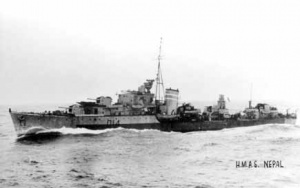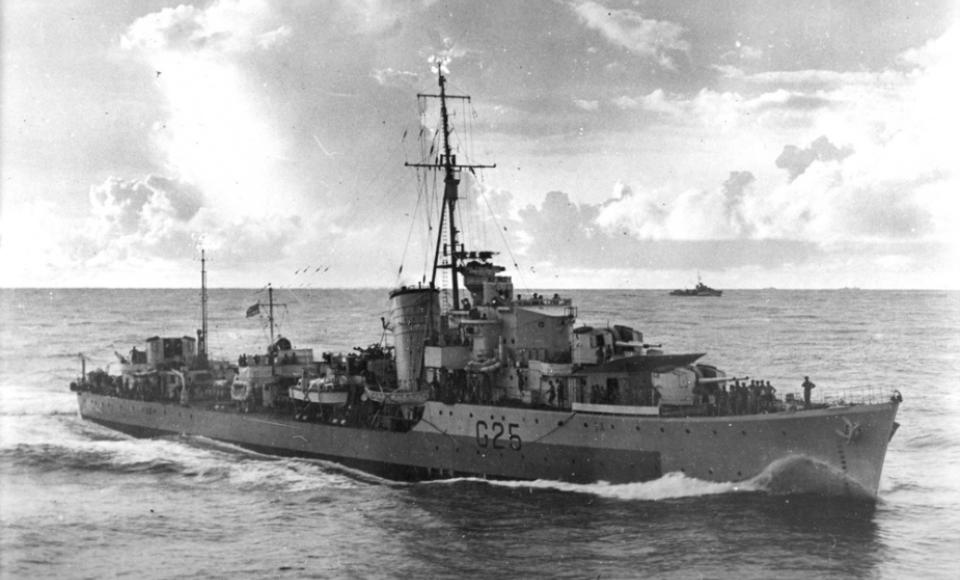HMAS Nepal was one of 8 N class destroyers laid down in British yards during 1939 to the order of the Royal Navy. Five (Napier, Nestor, Nepal, Nizam and Norman (I)) were transferred to the Royal Australian Navy (RAN), 2 to the Royal Netherlands Navy and one to the Polish Navy. The only one to become a war loss, HMAS Nestor, was sunk by air attack in the Mediterranean on 16 June 1942.
Nepal commissioned on 11 May 1942 under the command of Commander Franklyn B Morris RAN.
It was the last of the Australian N class destroyers to commission and began its war service with the Home Fleet at Scapa Flow. In June 1942 it returned to its builder’s yards at Southampton for docking in preparation for its movement to the Indian Ocean.
It was during this time that Nepal was used by Two Cities Films to represent the fictional destroyer HMS Torrin in the British war film In Which We Serve, starring Noel Coward. The film was based on the exploits of HMS Kelly while under the command of Coward’s friend Lord Louis Mountbatten.
In July 1942 it sailed from Glasgow for Kilindini where it joined ships of the same class Napier, Norman (I) and Nizam as a unit of the Eastern Fleet, on escort, fleet exercise and patrol duties. In September 1942 Nepal took part in the second phase of the Madagascar campaign. Operations beginning on 10 September with the capture of Majunga ended with the Allied occupation of the entire island and the surrender of the Vichy forces on 5 November 1942. Nepal was part of the forces assembled for the bloodless battle Tamatave, Madagascar’s chief port, captured on 18 September. The only shots fired by the Australian ships came from Norman (I).
Nepal spent the closing months of 1942 based at Kilindini, escorting convoys between Kilindini and Durban and on anti-submarine patrols in the Cape area. Under Commodore Arliss (Commodore (D)), Commander Morris performed the duties of Captain (D) with the Eastern Fleet.
Escort and general fleet duties kept Nepal fully occupied through the first 2 uneventful months of 1943. On 19 March 1943 it sailed from Durban for Australia, arriving in Fremantle on 3 April. En route it suffered slight damage when a severe cyclone was encountered between Mauritius and Diego Garcia. A refit at Sydney occupied the period of 8 April to 22 May 1943.
In June 1943 Nepal returned to Indian Ocean convoy escort and patrol duties, operating as a unit of the Eastern Fleet for the remainder of the year. Nepal remained with the Eastern Fleet through the first 7 months of 1944, operating from the reopened base at Trincomalee in Ceylon. Much of this period was spent in Indian waters, escorting and exercising with the fleet.
In April 1944 it was one of the destroyer screen protecting the carriers USS Saratoga and HMS Illustrious for the air strikes against the Japanese held port of Sabang in Sumatra. The following month, on 17 May, Nepal took part in the strike against Surabaya in Java by the same 2 carriers.
In August 1944 Nepal returned to Australian for refit. It then returned to the Eastern Fleet on 1 November when it arrived at Trincomalee in company with Napier. Fleet exercises and screening the carrier HMS Victorious to Mumbai occupied the remainder of November.
On 7 December 1944 Nepal joined Napier at Chittagong in India, preparatory to proceeding up the Mayer Peninsula as fire support ship to the 74th Indian Brigade ashore. Nepal began its support fire on 14 December when it fired on enemy gun positions. It was its first shot fired during the war. The bombardment of Japanese positions continued through the remainder of December, Nepal alternating with Napier as fire support destroyer, running to Chittagong every third day for stores and ammunition.
In January 1945 Nepal took part in further Burma operations, including the capture of Akyab Island on 3 January. The entire naval force for this combined operation comprised the cruisers, HM Ships Newcastle, Nigeria and Phoebe; the destroyers Napier, Nepal and HM Ships Pathfinder, Raider and Rapid; and the sloops, HM Ships Shoreham and Narbada and HMIS Jumna. The Japanese withdrawal turned the planned assault into a routing landing obviating any need for fire support from the sea. On 6 January Nepal left the Burma theatre for docking at Colombo.
On 25 January it returned to Burma for the seizure of Cheduba Island by Royal Marines of the Eastern Fleet, embarked in the cruisers Newcastle, Kenya and Nigeria. Nepal embarked to Commander-in-Chief, East Indies Fleet, Admiral Sir Arthur Power, who witnessed the operation from its decks. There was only minor opposition ashore. Nepal took no part in the bombardment.
On 1 February Nepal resumed an offensive role in the Burma theatre, shelling Japanese positions on Ramree Island on this and the succeeding 2 days. On 5 February it badly damaged its starboard propeller when it struck a submerged rock in the Kaleindaumg River. At this time, it was engaged in preventing the withdrawal of Japanese troops from Ramree Island. However, operating on one engine it remained in the Burma theatre until 12 February when its part in the operations ended.
On 1 March 1945 Nepal’s the Second World War service in the Indian Ocean finally ended when it sailed from Trincomalee to join the British Pacific Fleet in Sydney.
In April 1945 it joined the British Task Force 57 which participated in the invasion of Okinawa, Operation Iceberg, between March and May 1945.
During the closing stages of the Pacific War, Nepal continued operating as a fleet destroyer with the British Pacific Fleet, screening the Task Force or the replenishment fleet, the Fleet Train.
The period of 7 to 28 June 1945 was spent in Sydney and exercising with other ships of the 7th Flotilla at Jervis Bay. In July it rejoined the British Pacific Fleet at sea. The last day of hostilities found Nepal at Manus.
On 6 September 1945 Nepal arrived in Tokyo Bay, 4 days after the surrender ceremony. It spent 5 weeks in Japanese waters. On 22 October 1945 it returned to Sydney for reversion to the Royal Navy.
During its service with the RAN, Nepal steamed 224 628 miles and was 14 274 hours underway. Nepal was broken up in the United Kingdom in 1956.
HMAS Nepal decommissioned on 22 October 1945 after steaming over 200 000 miles for the RAN. It was transferred back to the Royal Navy and was broken up in 1956.
Specifications
 |
| Class |
N Class |
|---|---|
| Type |
Destroyer |
| Pennant |
G25 |
| Builder |
Thornycroft & Co, Southhampton, England |
| Laid Down |
9 September 1939 |
| Launched |
4 December 1941 |
| Commissioned |
11 May 1942 |
| Decommissioned |
22 October 1945 |
| Dimensions & Displacement | |
| Displacement |
|
| Length | 356 feet 6 inches |
| Beam | 35 feet 8 inches |
| Draught | 16 feet 4 inches (maximum) |
| Performance | |
| Speed | 36 knots |
| Complement | |
| Crew | 226 |
| Propulsion | |
| Machinery | Parsons geared turbines |
| Horsepower | 40,000 |
| Armament | |
| Guns |
|
| Torpedoes | 10 x 21-inch torpedo tubes (2 pentad mounts) |
| Other Armament |
|
| Awards | |
| Battle Honours |
|
